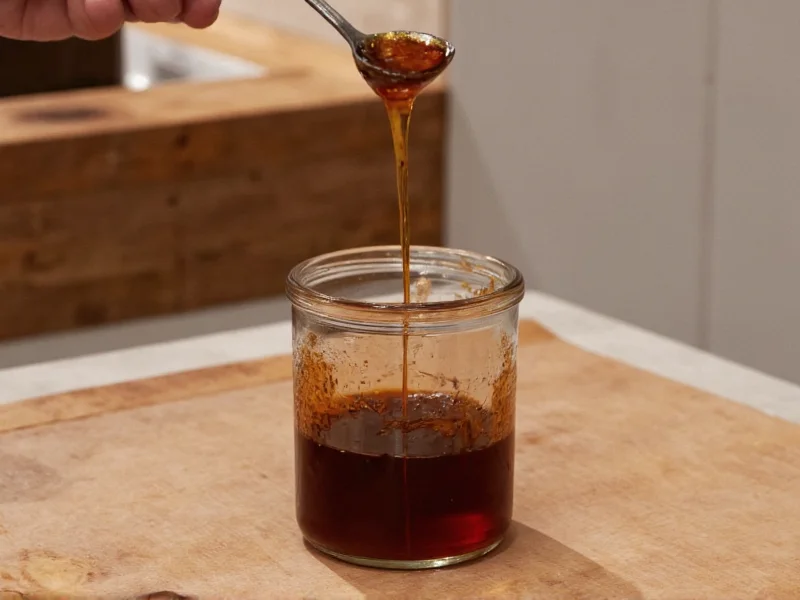Understanding how long opened molasses lasts is essential for home bakers and cooks who use this versatile sweetener occasionally. Unlike many pantry staples, molasses has remarkable longevity thanks to its chemical composition, but proper storage practices significantly impact its shelf life and quality preservation.
Factors That Determine Molasses Shelf Life
The actual longevity of your opened molasses depends on several key factors that interact to preserve or degrade its quality. Understanding these elements helps maximize your molasses' usable life.
Natural Preservation Properties
Molasses benefits from inherent preservation qualities due to its high sugar concentration (typically 65-80% sugar content) and low moisture activity. This environment naturally inhibits microbial growth that causes spoilage in many other food products. The acidity of molasses (pH around 5.0-5.5) further contributes to its stability.
Storage Conditions Matter Most
While unopened molasses can last indefinitely in proper conditions, opened containers face different challenges. The three critical storage factors affecting how long does opened molasses last are:
- Temperature stability - Fluctuations accelerate quality degradation
- Exposure to air - Causes crystallization and potential mold growth
- Light exposure - UV rays can break down compounds affecting flavor
Proper Storage Techniques for Maximum Longevity
Implementing correct storage methods significantly extends how long opened molasses lasts while maintaining optimal quality for your recipes.
Container Selection and Handling
Always transfer opened molasses to an airtight container if not using the original packaging. Glass jars with tight-sealing lids work better than plastic containers which may absorb odors. When pouring, use clean, dry utensils to prevent introducing moisture or contaminants that could compromise molasses shelf life after opening.
Optimal Storage Environment
The ideal storage location maintains consistent conditions:
| Storage Method | Expected Shelf Life | Quality Preservation |
|---|---|---|
| Pantry (cool, dark place) | 1-2 years | Excellent for first year, gradual thickening after |
| Refrigeration | 2-3 years | Prevents crystallization, maintains pourability |
| Room temperature (warm) | 6-12 months | Rapid thickening, potential separation |
While refrigeration isn't strictly necessary for safety, it significantly extends how long does opened molasses last with optimal texture and flavor. Many professional bakers prefer refrigerated storage to maintain consistent pourability.
Recognizing When Molasses Has Degraded
Though molasses rarely becomes unsafe to consume, its quality does diminish over time. Knowing the signs of degradation helps determine when to replace your supply.
Visual Indicators of Quality Loss
Examine your molasses for these visual changes that indicate declining quality:
- Surface mold - Any fuzzy growth means discard immediately
- Unusual separation - While some separation is normal, watery layers indicate quality loss
- Extreme darkening - Beyond normal deepening of color
- Crystallization - Small crystals may form but become problematic when widespread
Sensory Evaluation Techniques
Before using older molasses, perform these quick checks:
- Smell test - Fresh molasses has a rich, sweet aroma; sour or fermented odors indicate spoilage
- Texture assessment - Should pour smoothly; extreme thickening affects recipe performance
- Taste test - Small sample should have characteristic sweet, slightly bitter flavor without off-notes
Remember that does molasses go bad after opening is less about safety and more about quality. Properly stored molasses rarely becomes unsafe but will eventually lose its optimal baking properties.
Practical Tips for Extending Molasses Usability
These professional techniques help maintain your opened molasses in peak condition:
- Prevent crystallization - Place a clean ceramic magnet in the container (creates subtle energy field that inhibits crystal formation)
- Revive thickened molasses - Gently warm the sealed container in hot water for 10-15 minutes
- Measure accurately - Coat measuring utensils with cooking spray before pouring to prevent sticking
- Small batch storage - Transfer frequently used portions to smaller containers to minimize air exposure in the main supply
Understanding proper storage for opened molasses transforms this pantry staple from a potentially problematic ingredient into a reliably consistent component of your baking repertoire. The high sugar content that defines molasses also grants it exceptional shelf stability when handled correctly.
Frequently Asked Questions
Does opened molasses need to be refrigerated?
Refrigeration isn't required for safety but significantly extends quality. While how long does opened molasses last at room temperature is typically 1-2 years, refrigeration can extend this to 2-3 years while maintaining better pourability and preventing crystallization. If you use molasses infrequently, refrigeration is highly recommended.
Can you use molasses after the 'best by' date has passed?
Absolutely. The 'best by' date indicates peak quality, not safety. Properly stored opened molasses often remains usable for 1-2 years beyond this date. Always check for signs of spoilage like mold, unusual odors, or significant texture changes before using expired molasses. Most quality degradation affects recipe performance rather than safety.
Why does my opened molasses become so thick?
Molasses thickens over time due to water evaporation and sugar crystallization, especially when exposed to air. This is normal and doesn't indicate spoilage. To restore pourability, gently warm the sealed container in hot water for 10-15 minutes. For how long opened molasses lasts with optimal texture, store in an airtight container in a cool, dark place or refrigerate.
What causes mold to form on opened molasses?
Mold forms when moisture is introduced to the container, typically from using wet utensils or leaving the lid off for extended periods. The high sugar content normally prevents mold growth, but contamination changes this. If you see any mold on your molasses, discard the entire container immediately as mold roots penetrate deeper than visible. Always use clean, dry utensils when handling opened molasses storage.
How can I tell if my molasses has gone bad?
Check for these definitive signs that your molasses has spoiled: visible mold growth, sour or fermented odor, unusual watery separation that doesn't remix, or significant color lightening. While does molasses go bad after opening is uncommon due to its preservative properties, these indicators mean it should be discarded. Most often, molasses simply thickens or darkens over time without becoming unsafe.











 浙公网安备
33010002000092号
浙公网安备
33010002000092号 浙B2-20120091-4
浙B2-20120091-4